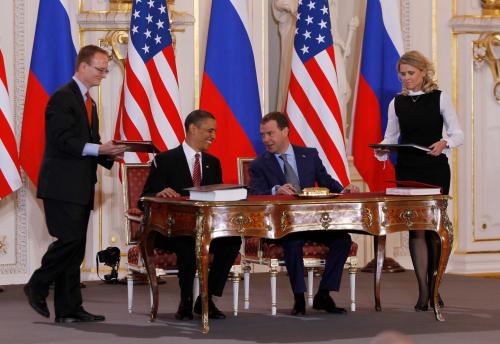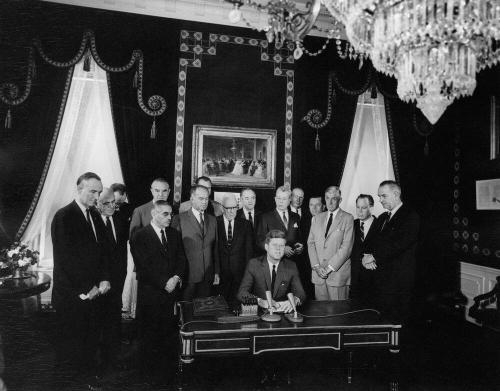Over the past several months, experts—including myself—have called on the Trump administration to extend the U.S.-Russia New Strategic Arms Reduction Treaty (New START). Extending the treaty by five years, as the agreement allows, helps maintain predictability and strategic stability with Russia, among other benefits. However, many of those same experts have also called for the cancellation of several U.S. nuclear delivery systems, in particular the Long-Range Stand-Off (LRSO) nuclear cruise missile and the Ground-Based Strategic Deterrent (GBSD) intercontinental ballistic missile. At the same time, recent press reports indicate that senior members of the Trump administration are long-standing opponents of New START, placing the prospects for the treaty’s extension in doubt.
Given these dynamics, it is useful to review the historical relationship between New START and the U.S. strategic nuclear modernization program. It is clear to me that the two issues are linked. Indeed, it is hard to see how the Obama administration would have been able to obtain Senate support to ratify New START had it not agreed to modernize the U.S. triad of strategic nuclear delivery vehicles and the supporting Department of Energy (DOE) nuclear infrastructure. On the other hand, it is difficult to imagine that the current bipartisan consensus on strategic modernization would have been achieved without New START or a similar arms control agreement.
An elusive consensus: The George W. Bush administration and strategic nuclear modernization
While many senior Bush administration officials advocated for the modernization of the U.S. strategic deterrent, the administration failed to make any significant progress towards making this goal a reality. This was a result of a number of factors, including the need to address the international terrorist threat, the ongoing wars in Iraq and Afghanistan, and the administration’s perceived indifference towards arms control and nonproliferation. As a result, the Bush administration’s two key nuclear modernization programs—the Robust Nuclear Earth Penetrator and the Reliable Replacement Warhead—were cancelled primarily due to congressional opposition from both Republican and Democrat-controlled Congresses.
Sensing the Bush administration’s inability to forge a bipartisan consensus on nuclear policy, Congress established in 2007 the Commission on the Strategic Posture of the United States, with former secretaries of defense William J. Perry and James R. Schlesinger serving as the chairman and vice chairman, respectively. In its 2009 report, the commission made a number of recommendations with regard to nuclear policy. Of particular note, the commission’s final report stated: “The United States should continue to pursue an approach to reducing nuclear dangers that balances deterrence, arms control, and nonproliferation. Singular emphasis on one or the other element would reduce the nuclear security of the United States.”
Enter Obama
Barack Obama entered office in 2009 with a strong interest in nuclear arms control and nonproliferation. Indeed, in April 2009, Obama delivered his first foreign policy speech in Prague outlining his long-term vision for a “world free of nuclear weapons.” In the same speech, Obama also noted that this was unlikely to happen during his lifetime, and so long as nuclear weapons existed, the United States would maintain a safe, secure, and effective deterrent.
The first step of the “Prague Agenda” was to negotiate a replacement for the START I Treaty, which was scheduled to expire in December 2009. Negotiations on the successor treaty, known as New START, began the following spring and the treaty was signed on April 8, 2010 in Prague. Once signed, New START needed to be sent to the U.S. Senate to obtain its advice and consent for ratification.
New START and the politics of strategic modernization
The Democrats held a 59-to-41 Senate majority in 2010 (including two independents who caucused with them), which was well below the 67-vote threshold needed to approve the treaty. Therefore, the Obama administration needed to win the support of at least eight Republican senators. Senate Republicans quickly made it known that the price for their votes would be funding for the strategic nuclear modernization program. In response, the Obama administration announced that it planned to spend over $80 billion (subsequently increased to $85 billion) over 10 years to improve DOE nuclear infrastructure. The administration also committed to retain the triad of strategic nuclear delivery vehicles and to modernize or replace those systems. With these commitments, the Senate provided its advice and consent for New START ratification by a vote of 71-26 in December 2010.
In a February 2011 message to the Senate, Obama expressed his intent to “modernize or replace the triad of nuclear delivery systems: a heavy bomber and air-launched cruise missile, and ICBM, and a nuclear-powered submarine (SSBN) and SLBM.” Without these commitments in favor of the strategic nuclear modernization program, it is hard to see how New START would have made it over the finish line in the Senate.
Conversely, New START helped bring reluctant Democrats on board with strategic modernization. As previously noted, the Bush administration struggled—unsuccessfully—to build bipartisan support for its nuclear modernization programs. Expressing their support for New START in a September 2010 article, Brent Scowcroft, former national security advisor during the Ford and George H.W. Bush administrations, and Jake Garn, former Republican senator from Utah, acknowledged this interrelationship. They wrote that New START
“provides a vehicle whereby some Democrats not usually known for their support of strategic systems can bring themselves to commit to modernization, while, at the same time, some Republicans not usually known for their support for arms control can bring themselves to vote for ratification. Conversely, rejecting the treaty may well break this consensus and result in no modernization of our forces.”
Maintaining the consensus
As I have written elsewhere, it is unclear whether the Trump administration will be able to maintain the domestic political consensus for the strategic nuclear modernization program that prevailed at the end of the Obama administration. The president’s inflammatory rhetoric, withdrawal from the Joint Comprehensive Plan of Action with Iran, and dysfunctional relationships with allies will make prospects for maintaining this consensus increasingly difficult. However, one thing the Trump administration could do to help maintain the consensus on modernization would be to extend New START. In addition to the many defense planning and intelligence benefits that extending the treaty would provide, it would also help maintain support among congressional Democrats for strategic modernization. This will be of particular importance if Democrats gain control of one or both houses of Congress in the November midterm elections.
At the same time, arms control advocates would be wise to remember that the Senate’s ultimate support for New START was directly tied to funding the modernization of the strategic nuclear triad and the related DOE infrastructure. If these commitments are not kept, what little bipartisan support that remains for arms control will likely collapse.
President Harry Truman once said that the Marshall Plan and the Truman Doctrine were “two halves of the same walnut,” arguing that both were necessary to maintain stability and security in Europe. In many ways, New START and the strategic nuclear modernization program are similar, as it is hard to see how the United States will be able maintain a bipartisan consensus for one without the other.



Commentary
“Two halves of the same walnut”: The politics of New START extension and strategic nuclear modernization
August 30, 2018